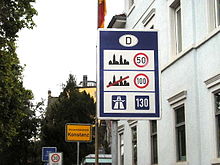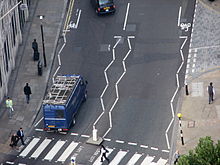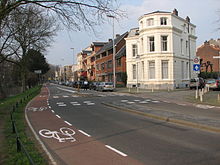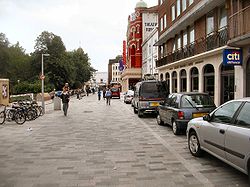- Road traffic safety
-
The term road traffic safety is an indication of how safe individual users are on some particular road, or on the roads belonging to some region. The main danger to road users is the likelihood of a traffic collision. Such dangers can be reduced by individual road users operating cautiously and defensively, by building roads in alignment with competent traffic engineering practices, by the application of rational traffic control methods, and by designing road vehicles so they are more able to avoid and survive collisions.
Contents
Background
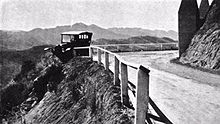 Guardrails save a vehicle from a long fall c. 1920.
Guardrails save a vehicle from a long fall c. 1920.
Road traffic crashes are one of the world’s largest public health and injury prevention problems. The problem is all the more acute because the victims are overwhelmingly healthy prior to their crashes. According to the World Health Organization (WHO), more than a million people are killed on the world’s roads each year.[1] A report published by the WHO in 2004 estimated that some 1.2m people were killed and 50m injured in traffic collisions on the roads around the world each year[2] and was the leading cause of death among children 10 – 19 years of age. The report also noted that the problem was most severe in developing countries and that simple prevention measures could halve the number of deaths.[3]
The standard measures used in assessing road safety interventions are fatalities and Killed or Seriously Injured (KSI) rates, usually per billion (109) passenger kilometres. In the United States, crashes per million vehicle miles is typically used for road safety.
Speed is a key goal of modern road design, but impact speed affects the severity of injury to both occupants and pedestrians. For occupants, Joksch (1993) found the probability of death for drivers in multi-vehicle accidents increased as the fourth power of impact speed (often referred to by the mathematical term δv ("delta V"), meaning change in velocity). Injuries are caused by sudden, severe acceleration (or deceleration), this is difficult to measure. However, crash reconstruction techniques can be used to estimate vehicle speeds before a crash. Therefore, the change in speed is used as a surrogate for acceleration.
Interventions take many forms. Contributing factors to highway crashes may be related to the driver (such as driver error, illness or fatigue), the vehicle (brake, steering, or throttle failures) or the road itself (lack of sight distance, poor roadside clear zones, etc.). Interventions may seek to reduce or compensate for these factors, or reduce the severity of crashes that do occur. A comprehensive outline of interventions areas can be seen in Management systems for road safety.
Interventions for the prevention of road traffic injuries are often evaluated; the Cochrane Library has published a wide variety of reviews of interventions for the prevention of road traffic injuries.[4][5]
For road traffic safety purposes it can be helpful to classify roads into ones in built-up area, non built-up areas and then major highways (Motorways/Freeways etc.) Most casualties occur on roads in built-up areas and major highways are the safest in relation to vehicle mileage. Reported Road Casualties Great Britain for 2008 show that the vast majority of injuries occur in built-up areas but that most fatalities occur on non built-up roads.[6]
Road Type Killed Serious injury Slight injury total injury ref Note Non Built-up (excludes motorways) 1,323 8,342 48,810 58,475 52% of the total killed, 32% of total seriously injured, 25% of total with slight injuries Built-up 1,057 16,823 143,079 160,959 42% of the total killed, 65% of total seriously injured, 70% of total with slight injuries Motorway 158 869 10,444 11,471 [7] 6% of the total killed, 3% of total seriously injured, 5% of total with slight injuries. Fatalities on motorways have decreased by 9 per cent since 1994-98 in a period with traffic levels increased by 28%"[8] All casualties 2,538 26,034 202,333 230,905 [9] Built-up areas
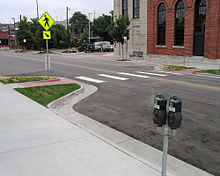 A curb extension at a mid-block crosswalk
A curb extension at a mid-block crosswalk Utrecht has specially-painted bicycle-only lanes.
Utrecht has specially-painted bicycle-only lanes.
On neighborhood roads where many vulnerable road users, such as pedestrians and bicyclists can be found, traffic calming can be a tool for road safety. Shared space schemes, which rely on human instincts and interactions, such as eye contact, for their effectiveness, and are characterised by the removal of traditional traffic signals and signs, and even by the removal of the distinction between carriageway (roadway) and footway (sidewalk), are also becoming increasingly popular. Both approaches can be shown to be effective.
Modern safety barriers are designed to absorb impact energy and minimize the risk to the occupants of cars, and bystanders. For example, most side rails are now anchored to the ground, so that they cannot skewer a passenger compartment, and most light poles are designed to break at the base rather than violently stop a car that hits them. Some road fixtures such as road signs and fire hydrants are designed to collapse on impact. Highway authorities have also removed trees in the vicinity of roads; while the idea of "dangerous trees" has attracted a certain amount of skepticism, unforgiving objects such as trees can cause severe damage and injury to any errant road users.
Most roads are cambered (crowned), that is, made so that they have rounded surfaces, to reduce standing water and ice, primarily to prevent frost damage but also increasing traction in poor weather. Some sections of road are now surfaced with porous bitumen to enhance drainage; this is particularly done on bends. These are just a few elements of highway engineering. As well as that, there are often grooves cut into the surface of cement highways to channel water away, and rumble strips at the edges of highways to rouse inattentive drivers with the loud noise they make when driven over. In some cases, there are raised markers between lanes to reinforce the lane boundaries; these are often reflective. In pedestrian areas, speed bumps are often placed to slow cars, preventing them from going too fast near pedestrians.
Poor road surfaces can lead to safety problems. If too much asphalt or bitumenous binder is used in asphalt concrete, the binder can 'bleed' or flush' to the surface, leaving a very smooth surface that provides little traction when wet. Certain kinds of stone aggregate become very smooth or polished under the constant wearing action of vehicle tyres, again leading to poor wet-weather traction. Either of these problems can increase wet-weather crashes by increasing braking distances or contributing to loss of control. If the pavement is insufficiently sloped or poorly drained, standing water on the surface can also lead to wet-weather crashes due to hydroplaning.
Lane markers in some countries and states are marked with Cat's eyes or Botts dots, bright reflectors that do not fade like paint. Botts dots are not used where it is icy in the winter, because frost and snowplows can break the glue that holds them to the road, although they can be embedded in short, shallow trenches carved in the roadway, as is done in the mountainous regions of California.
Road hazards and intersections in some areas are now usually marked several times, roughly five, twenty and sixty seconds in advance so that drivers are less likely to attempt violent manoeuvres.
Most road signs and pavement marking materials are retro-reflective, incorporating small glass spheres or prisms to more efficiently reflect light from vehicle headlights back to the driver's eyes.
Designing for pedestrians and cyclists
Pedestrians and Cyclists are among the most vulnerable road users,[10] and in some countries constitute over half of all road deaths. Interventions aimed at improving safety of non-motorised users:
- Sidewalks of suitable width for the expected pedestrian traffic
- pedestrian crossings close to the desire line which allow pedestrians to cross roads safely
- segregated pedestrian routes and cycle lanes away from the main highway
- Overbridges (tend to be unpopular with pedestrians and cyclists due to additional distance and effort)
- Underpasses (these can pose heightened risk from crime is not designed well, can work for cyclists in some cases)
- traffic calming and speed humps
- low speed limits that are rigorous enforced, possibly by speed cameras
- shared space schemes giving ownership of the road space and equal priority to all road users, regardless of mode of use
- pedestrian barriers to prevent pedestrians crossing dangerous locations
Pedestrians' advocates question the equitability of schemes if they impose extra time and effort on the pedestrian to remain safe from vehicles, for example overbridges with long slopes or steps up and down, underpasses with steps and addition possible risk of crime and at-grade crossings off the desire line. The Make Roads Safe was criticised in 2007 for proposing such features. Successful pedestrian schemes tend to avoid over-bridges and underpasses and instead use at-grade crossings (such as pedestrian crossings) close the intended route. Successful cycling scheme by contrast avoid frequent stops even if some additional distance is involved given that the main effort required for cyclists is starting off.
In Costa Rica 57% of road deaths are pedestrians, however a partnership between AACR, Cosevi, MOPT and iRAP has proposed the construction of 190 km of pedestrian footpaths and 170 pedestrian crossings which could save over 9000 fatal or serious injuries over 20 years.[11]
Main article: Shared spaceBy 1947 the Pedestrians' Association was suggesting that many of the safety features being introduced (speed limits, traffic calming, road signs and road markings, traffic lights, Belisha beacons, pedestrian crossings, cycle lanes etc.) were potentially self defeating because "every nonrestrictive safety measure, however admirable in itself, is treated by the drivers as an opportunity for more speeding, so that the net amount of danger is increased and the latter state is worse than the first."[12]
During the 1990s a new approach, known as 'shared space' was developed which removed many of these features in some places has attracted the attention of authorities around the world.[13][14] The approach was developed by Hans Monderman who believed that "if you treat drivers like idiots, they act as idiots"[15] and proposed that trusting drivers to behave was more successful than forcing them to behave.[16] Professor John Adams, an expert on risk compensation suggested that traditional traffic engineering measures assumed that motorists were "selfish, stupid, obedient automatons who had to be protected from their own stupidity" and non-motorists were treated as "vulnerable, stupid, obedient automatons who had to be protected from cars – and their own stupidity".[17]
Reported results indicate that the shared space approach leads to significantly reduced traffic speeds, the virtual elimination of road casualties, and a reduction in congestion.[16] Living streets share some similarities with shared spaces. The woonerven also sought to reduce traffic speeds in community and housing zones by the use of lower speed limits enforced by the use of special signage and road markings, the introduction of traffic calming measures, and by giving pedestrians priority over motorists.
Non built-up areas
Major highways
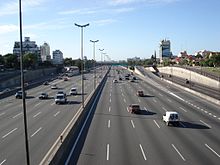 The Pan-American Highway with central median and no freestanding obstructions
The Pan-American Highway with central median and no freestanding obstructions
Major highways including motorways, freeways, Autobahnen and Interstates are designed for safer high-speed operation and generally have lower levels of injury per vehicle km than other roads.
Safety features include:
- limited access from properties and local roads.
- Grade separated junctions
- Median dividers between opposite-direction traffic to reduce likelihood of head-on collisions
- Removing roadside obstacles.
- Prohibition of more vulnerable road users and slower vehicles.
- Placements of energy attenuation devices (e.g. guard rails, wide grassy areas, sand barrels).
- Eliminating road toll booths
The ends of some guard rails on high-speed highways in the United States are protected with impact attenuators, designed to gradually absorb the kinetic energy of a vehicle and slow it more gently before it can strike the end of the guard rail head on, which would be devastating at high speed. Several mechanisms are used to dissipate the kinetic energy. Fitch Barriers, a system of sand-filled barrels, uses momentum transfer from the vehicle to the sand. Many other systems tear or deform steel members to absorb energy and gradually stop the vehicle.
In some countries major roads have "tone bands" impressed or cut into the edges of the legal roadway, so that drowsing drivers are awakened by a loud hum as they release the steering and drift off the edge of the road. Tone bands are also referred to as "rumble strips," owing to the sound they create. An alternative method is the use of "Raised Rib" markings, which consists of a continuous line marking with ribs across the line at regular intervals. They were first specially authorised for use on motorways as an edge line marking to separate the edge of the hard shoulder from the main carriageway. The objective of the marking is to achieve improved visual delineation of the carriageway edge in wet conditions at night. It also provides an audible/vibratory warning to vehicle drivers, should they stray from the carriageway, and run onto the marking.
Better motorways are banked on curves in order to reduce the need for tire-traction and increase stability for vehicles with high centers of gravity.
An example of the importance of roadside clear zones can be found on the Isle of Man TT motorcycle race course. It is much more dangerous than Silverstone because of the lack of runoff. When a rider falls off at Silverstone he slides along slowly losing energy, so minimal injuries. When he falls of in the Manx he impacts with trees and walls. Similarly, a clear zone alongside a freeway or other high speed road can prevent off-road excursions from becoming fixed-object crashes.
The U.S. has developed a prototype automated roadway, to reduce driver fatigue and increase the carrying capacity of the roadway. Roadside units participating in future Wireless vehicle safety communications networks have been studied.
Motorways are far more expensive and space-consumptive to build than ordinary roads, so are only used as principal arterial routes. In developed nations, motorways bear a significant portion of motorized travel; for example, the United Kingdom's 3533 km of motorways represented less than 1.5% of the United Kingdom's roadways in 2003, but carry 23% of road traffic.
The proportion of traffic borne by motorways is a significant safety factor. For example, even though the United Kingdom had a higher fatality rates on both motorways and non-motorways than Finland, both nations shared the same overall fatality rate in 2003. This result was due to the United Kingdom's higher proportion of motorway travel.
Similarly, the reduction of conflicts with other vehicles on motorways results in smoother traffic flow, reduced collision rates, and reduced fuel consumption compared with stop-and-go traffic on other roadways.
The improved safety and fuel economy of motorways are common justifications for building more motorways. However, the planned capacity of motorways is often exceeded in a shorter timeframe than initially planned, due to the under estimation of the extent of the suppressed demand for road travel. In developing nations, there is significant public debate on the desirability of continued investment in motorways.
Motorways around the world are subject to a broad range of speed limits. Recent experiments with variable speed limits based on automatic measurements of traffic density have delivered both improvements in traffic flow and reduced collision rates, based on principles of turbulent flow analysis.[citation needed]
With effect from January 2005 and based primarily on safety grounds, the UK’s Highways Agency's policy is that all new motorway schemes are to use high containment concrete step barriers in the central reserve. All existing motorways will introduce concrete barriers into the central reserve as part of ongoing upgrades and through replacement as and when these systems have reached the end of their useful life. This change of policy applies only to barriers in the central reserve of high speed roads and not to verge side barriers. Other routes will continue to use steel barriers.
30% of highway crashes that occur in the vicinity of toll collection booths in the countries that have them, these can be eliminated by switching to a system of government taxation for road use.[18]
Vehicle safety
Buses and coaches
Cars
Main article: Automobile safety Simulated crashes using crash test dummies can help improve automobile design
Simulated crashes using crash test dummies can help improve automobile designSafety can be improved by reducing the chances of a driver making an error, or by designing vehicles to reduce the severity of crashes that do occur. Most industrialized countries have comprehensive requirements and specifications for safety-related vehicle devices, systems, design, and construction. These may include:
- Passenger restraints such as seat belts — often in conjunction with laws requiring their use — and airbags
- Crash avoidance equipment such as lights and reflectors
- Driver assistance systems such as Electronic Stability Control
- Crash survivability design including fire-retardant interior materials, standards for fuel system integrity, and the use of safety glass
- Sobriety detectors: These interlocks prevent the ignition key from working if the driver breathes into one and it detects significant quantities of alcohol. They have been used by some commercial transport companies, or suggested for use with persistent drunk-driving offenders on a voluntary basis[19]
Motorbikes
Main article: Motorcycle safetyTrucks
According to the European Commission Transportation Department "it has been estimated that up to 25% of accidents involving trucks can be attributable to inadequate cargo securing" [1]. Improperly secured cargo can cause severe accidents and lead to loss of cargo, loss of lives, loss of vehicles and can be a hazard for the environment. One way to stabilize, secure and protect cargo during transportation on the road is by using Dunnage Bags which are placed in the void between the cargo and are designed to prevent the load from moving during transport.
Regulation of road users
Various types of road user regulations are in force or have been tried in most jurisdictions around the world, some these are discussed by road user type below.
Motor vehicle users
Dependent on jurisdiction, driver age, road type and vehicle type, motor vehicle drivers may be required to pass a driving test (public transport and goods vehicle drivers may need additional training and licensing), conform to restrictions on driving after consuming alcohol or various drugs, comply with restrictions on use of mobile phones, be covered by compulsory insurance, wear seat belts and comply with certain speed limits. Motorcycle riders may additionally be compelled to wear a motorcycle helmet. Drivers of certain vehicle types may be subject to maximum driving hour regulations.
Some jurisdictions such as Virginia, U.S. and in Maryland, U.S. are targeting specific regulations such as the prohibiting mobile phone use and limiting passenger numbers at young and inexperienced drivers.[20] It has been noticed that more of these types of serious collision occur at night, when the car has multiple occupants and when seat belt use is less.[21]
Insurance companies[which?] have proposed[where?] that the following restrictions should be imposed on new drivers:[citation needed] a "curfew" imposed on young drivers to prevent them driving at night, an experienced supervisor to chaperone the less experienced driver, forbidding the carrying of passengers, zero alcohol tolerance, raising the standards required for driving instructors and improving the driving test, vehicle restrictions (e.g. restricting access to 'high performance' vehicles), a sign placed on the back of the vehicle (an N- or P-Plate) to notify other drivers of a novice driver and encouraging good behaviour in the post-test period.
Some countries or states have already implemented some of these ideas.[citation needed] Pay-as-you-drive adjusts insurance costs according to when and where the person drives.
Pedal bicycle users
Dependent on jurisdiction, road type and age, pedal cyclists may be required conform to restrictions on driving after consuming alcohol or various drugs, comply with restrictions on use of mobile phones, be covered by compulsory insurance, wear a bicycle helmet and comply with certain speed limits.
Pedestrians
Dependent on jurisdiction, jaywalking may be prohibited.
Information campaigns
Information campaigns can be used to raise awareness of initiatives designed to reduce road casualty levels. Examples include:
- Decade of Action by World Health Organization and Fédération Internationale de l'Automobile (2011-2020)
- traffic awareness campaigns such as the "one false move" campaign documented by Hillman et al.
- Speeding. No one thinks big of you. (New South Wales, Australia, 2007)
- Road Safety is no Accident World Health Organization
- Designated driver campaign, (U.S., 1970s-present)
- Click It or Ticket, (U.S., 1993–present)
- Clunk Click Every Trip (UK 1971)
- Green Cross Code (UK 1970–present)
Statistics
Rating roads for safety
Since 1999 the EuroRAP initiative has been assessing major roads in Europe with a road protection score. This results in a star rating for roads based on how well its design would protect car occupants from being severely injured or killed if a head-on, run-off, or intersection accident occurs, with 4 stars representing a road with the best survivability features.[22] The scheme states it has highlighted thousands of road sections across Europe where road-users are routinely maimed and killed for want of safety features, sometimes for little more than the cost of safety fencing or the paint required to improve road markings.[23]
There are plans to extend the measurements to rate the probability of an accident for the road. These ratings are being used to inform planning and authorities' targets. For example, in Britain two-thirds of all road deaths in Britain happen on rural roads, which score badly when compared to the high quality motorway network; single carriageways claim 80% of rural deaths and serious injuries, while 40% of rural car occupant casualties are in cars that hit roadside objects, such as trees. Improvements in driver training and safety features for rural roads are hoped to reduce this statistic.[24]
The number of designated traffic officers in the UK fell from 15–20% of Police force strength in 1966 to seven per cent of force strength in 1998, and between 1999 and 2004 by 21%.[25] It is an item of debate whether the reduction in traffic accidents per 100 million miles driven over this time[26] has been due to robotic enforcement.
KSI by country
Country Killed per 1 Billion Veh·km (Motorways in 2003) Killed per 1 Billion Veh·km (Non-Motorways in 2003) Motorway AADT Road Travel by Motorway km/h (mph) Motorway 2003 Speed Limit  Austria
Austria5.9 13.4 30,077 23% 130 (80)  Czech Republic
Czech Republic9.9 34.3 25,714 11% 130 (80)  Denmark
Denmark3.0 11.9 29,454 25% 110 (70)  Finland
Finland1.4 8.3 22,780 10% 120 (75)  France
France4.0 12.8 31,979 21% 130 (80)  Germany
Germany3.8 12.4 48,710 31% none
(130 (80) advisory) Ireland
Ireland7.4 11.0 26,730 4% 120 (75)  Italy
Italy13.0 Unknown Unknown Unknown 130 (80)  Japan
Japan4.0 11.9 26,152 9% 100 (60)  Netherlands
Netherlands2.1 11.7 66,734 41% 120 (75)  Slovenia
Slovenia8.1 18.7 15,643 19% 130 (80)  Spain
Spain62.3 Unknown Unknown Unknown 120 (75)  Sweden
Sweden2.5 9.9 24,183 21% 110 (70)  Switzerland
Switzerland2.8 11.8 43,641 33% 120 (75)  United Kingdom
United Kingdom2.0 9.3 85,536 23% 110 (70)  United States
United States5.2 10.7 39,634 24% 120 (75) definition: AADT - average annual daily traffic. The bi-direction traffic count representing an average 24-hour day in a year. Sometimes called "traffic density" although it ignores or assumes a constant number of travel lanes.
source: International Road Traffic and Accident Database (IRTAD) [2], Risk Values in 2003 and ABD and Selected References Values for 2003 -- courtesy of the Bundesanstalt für Straßenwesen, that is, the (German) Federal Highway Research Institute. Travel was computed by dividing the fatality rate by the number of fatalities; AADT by dividing travel by the length of the motorway network. 2003 speed limits were obtained from the Wiki page and verified with other sources.
Advocacy groups
The Automobile Association was established in 1905 in the United Kingdom to help motorists avoid police speed traps.[27] They became involved in other safety issues and also erected thousands of roadside warning signs.[27]
The Pedestrians Association in the United Kingdom was formed in 1929 to press for better road safety. Other groups have been active in other countries.[citation needed]
The International Road Federation has an issue area and working group dedicated to road safety. They work with their membership to advocate measures that improve road safety through infrastructure and cooperation with other international organizations.[28]
Motoring advocacy groups including the Association of British Drivers (UK), Speed cameras.org[29] (UK), National Motorists Association (USA/Canada) argue that the strict enforcement of speed limits does not necessarily result in safer driving, and may even have negative effect on road safety in general. Safe Speed is a UK group set up specifically to campaign against the use of Speed cameras. The Association of British Drivers also argues that speed humps result in increased air pollution, increased noise pollution, and even unnecessary vehicle damage.[citation needed]
In 1965, Ralph Nader put pressure on car manufactures in his book Unsafe at Any Speed detailing resistance by car manufacturers to the introduction of safety features, like seat belts, and their general reluctance to spend money on improving safety. The GM President James Roche was later forced to appear before a United States Senate subcommittee, and to apologize to Nader for the company's campaign of harassment and intimidation. Nader later successfully sued GM for excessive invasion of privacy.[30]
RoadPeace was formed in 1991 in the United Kingdom to advocate for better road safety and founded World Day of Remembrance for Road Traffic Victims in 1993 which received support from the United Nations General Assembly in 2005.[31][32]
There is some controversy over the way that the motor advocacy groups has been seen to dominate the road safety agenda.[citation needed] Some road safety activists use the term "road safety" (in quotes) to describe measures such as removal of "dangerous" trees and forced segregation of the vulnerable to the advantage of motorized traffic. Orthodox "road safety" opinion fails to address what Adams describes as the top half of the risk thermostat, the perceptions and attitudes of the road user community.[citation needed]
Criticisms
Some road-safety groups[who?] argue that the problem of road safety is largely being stated in the wrong terms because most road safety measures are designed to increase the safety of drivers, but many road traffic casualties are not drivers (in the UK only 40% of casualties are drivers), and those measures which increase driver safety may, perversely, increase the risk to these others, through risk compensation.[citation needed]
The core elements of the thesis are:[citation needed]
- that vulnerable road users are marginalised by the "road safety" establishment
- that "road safety" interventions are often centred around reducing the severity of results from dangerous behaviours, rather than reducing the dangerous behaviours themselves
- that improved "road safety" has often been achieved by making the roads so hostile that those most likely to be injured cannot use them at all
- that the increasing "safety" of cars and roads is often counteracted wholly or in part by driver responses (risk compensation).
RoadPeace and other groups have been strongly critical of what they see as moves to solve the problem of danger posed to vulnerable road users by motor traffic through increasing restrictions on vulnerable road users, an approach which they believe both blames the victim and fails to address the problem at source.[citation needed] This is discussed in detail by Dr Robert Davis in the book Death on the Streets: Cars and the mythology of road safety, and the core problem is also addressed in books by Professor John Adams, Mayer Hillman and others.[citation needed]
For example; the UK publishes Road Casualties Great Britain each year detailing reported road fatalities and injuries and claims to have among the best pedestrian safety in Europe with falling injury rates, as measured in pedestrian KSI per head of population.[33] A study published by the British Medical Journal in 2006 suggested that the reduction in injury levels was due to lower levels of reporting not reducing levels of injury as such.[34] Considerable under-reporting was confirmed by a second report prepared for the UK Department for Transport.[35] and the UK government now acknowledges the issue of under-reporting but is not convinced that the reductions in reported injury levels do not reflect an actual decline.[36] Another independent report investigated if the roads were actually sufficiently dangerous as to deter pedestrians from using them at all.[37]
See also
References
Notes
- ^ Statistical Annex - World report on road traffic injury prevention
- ^ "World report on road traffic injury prevention". World Health Organisation. http://www.who.int/violence_injury_prevention/publications/road_traffic/world_report/en/index.html. Retrieved 2010-04-14.
- ^ "UN raises child accidents alarm". BBC News. 2008-12-10. http://news.bbc.co.uk/2/hi/in_depth/7776127.stm. Retrieved 2010-05-22.
- ^ "Speed Cameras". ROSPA. http://www.rospa.com/roadsafety/adviceandinformation/driving/speed/speed-cameras.aspx. "The Cochrane Collaboration published out a second systematic review in 2006, which was updated in 2010. These studies only included before-and-after trials with comparison areas and interrupted time series studies."
- ^ "Reduce Injuries Associated with Motor Vehicle Crashes". Centers for Disease Control and Prevention. http://www.cdc.gov/transportation/references.htm. "Alcohol ignition interlock programmes for reducing drink driving recidivism. Cochrane Database of Systematic Reviews, Issue 3. Article No.: CD004168. DOI: 10.1002/14651858.CD004168.pub2."
- ^ Department for Transport (2008), p. 121 table 12 'Reported accidents, vehicles and casualties: casualties by severity: by road class, built-up and non built-up roads: 2008'
- ^ "Number of road deaths falls to lowest level since records began in 1926". Daily Mail (London). http://www.dailymail.co.uk/news/article-1195412/Number-road-deaths-2008-lowest-records-began-1926.html.
- ^ "Fatalities 2008". http://www.dft.gov.uk/pgr/statistics/datatablespublications/accidents/casualtiesgbar/suppletablesfactsheets/fatalities2008.pdf.
- ^ "Road Casualties in Great Britain Main Results: 2008". Department for Transport. p. 6. http://www.dft.gov.uk/adobepdf/162469/221412/221549/227864/479748/rcgbmainresults08.pdf. Retrieved 2010-04-21.
- ^ "Vehicle Pedestrian Crashes". International Road Assessment Programme. http://www.irap.net/toolkit/default.asp?p=crash&ds=1&i=8. Retrieved 2008-09-26.
- ^ "Vaccines for Roads; The new iRAP tools and their pilot application" (PDF). International Road Assessment Programme. http://www.irap.net/documents/pdf/08%2006%201047%20iRAP_Pilotweb.pdf. Retrieved 2008-09-26.[dead link]
- ^ J.S.Dean. Murder most foul. http://issuu.com/carltonreid/docs/murder-most-foul.
- ^ Matthias Schulz (2006-11-16). "European Cities Do Away with Traffic Signs". Spiegel Online. http://www.spiegel.de/international/spiegel/0,1518,448747,00.html. Retrieved 2008-02-27.
- ^ Ted White (September 2007). "Signing Off: Visionary traffic planners". Urbanite Baltimore. http://www.urbanitebaltimore.com/sub.cfm?issueID=52§ionID=4&articleID=748. Retrieved 2008-02-27.
- ^ "Obituaries: Hans Monderman". The Times (London: Times Newspapers Ltd). 2008-01-11. http://www.timesonline.co.uk/tol/comment/obituaries/article3167372.ece. Retrieved 2008-02-27.
- ^ a b Andrew Gilligan (2008-02-07). "It's hell on the roads, and I know who's to blame". The Evening Standard (Associated Newspapers Limited). http://www.thisislondon.co.uk/standard/article-23436116-details/It's+hell+on+the+roads,+and+I+know+who's+to+blame/article.do. Retrieved 2008-02-27.
- ^ Professor John Adams (2007-09-02). "Shared Space – would it work in Los Angeles?" (PDF). John Adams. http://john-adams.co.uk/wp-content/uploads/2007/09/shared-space-for-la-times.pdf. Retrieved 2008-02-27.
- ^ "Bringing U.S. Roads into the 21st Century". http://www.issues.org/26.4/ezell.html.
- ^ Primary and secondary prevention of drink driving by the use of alcolock device and program: Swedish experiences. 37. Accident Analysis & Prevention. November 2005. doi:10.1016/j.aap.2005.06.020. http://www.sciencedirect.com/science?_ob=ArticleURL&_udi=B6V5S-4GSBGX2-1&_user=10&_rdoc=1&_fmt=&_orig=search&_sort=d&view=c&_acct=C000050221&_version=1&_urlVersion=0&_userid=10&md5=cbff22840ae86c348e03473388eeadc5. Retrieved 2008-01-06.
- ^ Williamson, Elizabeth (2005-02-01). "Brain Immaturity Could Explain Teen Crash Rate". Washington Post. http://www.washingtonpost.com/wp-dyn/articles/A52687-2005Jan31.html.
- ^ "The Good, the Bad and the Talented: Young Drivers' Perspectives on Good Driving and Learning to Drive" (PDF). Road Safety Research Report No. 74. Transport Research Laboratory. January 2007. http://www.dft.gov.uk/pgr/roadsafety/research/rsrr/theme2/pdfgoodbadtalenteddriver.pdf. Retrieved 2008-01-04.
- ^ "Star rating roads for safety: UK trials 2006-07". EuroRAP. 2007-12-03. http://www.eurorap.org/news_item?search=y&ID=39. (Note: see country maps here)
- ^ John Dawson, John. "Chairman's Message". http://www.eurorap.org/about.
- ^ "Star rating roads for safety, UK trials 2006-07" (PDF). TRL, EuroRAP & ADAC. December 2007. http://www.eurorap.org/library/pdfs/20071130_UK_RPS_report.pdf.
- ^ Section 21, traffic officer numbers reduction in the UK
- ^ page 147 Transport statistics 2009 edition
- ^ a b "About us". The AA. http://www.theaa.com/aboutaa/history.html. Retrieved 2010-02-26.
- ^ IRF Road Safety.
- ^ Speed cameras.org
- ^ Nader v. General Motors Corp. Court of Appeals of New York, 1970
- ^ "about". World Day of Remembrance. http://www.worlddayofremembrance.org/about-world-day. Retrieved 2010-02-26.
- ^ United Nations General Assembly Resolution 5 session 60 Improving global road safety page 3 on 26 October 2005
- ^ "Reported Road Casualties Great Britain: 2008 - Annual Report". UK Department for Transport. http://www.dft.gov.uk/pgr/statistics/datatablespublications/accidents/casualtiesgbar/rrcgb2008. Retrieved 2010-01-13.
- ^ Mike Gill, Michael J Goldacre, David G R Yeates (2006-06-23) (PDF). Changes in safety on England’s roads: analysis of hospital statistics. BMJ. http://bmj.bmjjournals.com/cgi/rapidpdf/bmj.38883.593831.4Fv1.pdf.
- ^ Heather Ward, Ronan Lyons, Roselle Thoreau (June 2006) (PDF). Road Safety Research Report No. 69: Under-reporting of Road Casualties – Phase 1. UK Department for Transport. http://www.dft.gov.uk/stellent/groups/dft_rdsafety/documents/page/dft_rdsafety_611755.pdf.
- ^ "Reported Road Casualties Great Britain: 2008 Annual Report". Department for Transport. p. 62. http://www.dft.gov.uk/adobepdf/162469/221412/221549/227755/rrcgb2008.pdf. Retrieved 2010-01-10. ""It has long been known that a considerable proportion of non-fatal casualties are not known to the police and hospital, survey and compensation claims data all indicate a higher number of casualties than are reported... Police data on road accidents (STATS19), whilst not perfect, remains the most detailed, complete and reliable single source of information on road casualties covering the whole of Great Britain, in particular for monitoring trends over time""
- ^ One False Move. ISBN 0 85374 494 7. http://www.psi.org.uk/publications/ENVIRON/onefm.htm. Retrieved 2010-01-13.
Sources
- Department for Transport (2008). "Reported Road Casualties Great Britain: 2008 Annual Report". Road Casualties Great Britain. http://www.dft.gov.uk/adobepdf/162469/221412/221549/227755/rrcgb2008.pdf. Retrieved 2010-01-09.
- Mayer Hillman, John Adams, John Whitelegg (1991, 2000). One False Move: a study of children's independent mobility. Policy Studies Institute. ISBN 0853744947.
- Robert Davis (1993). Death on the Streets: Cars and the mythology of road safety. Leading Edge Press. ISBN 0948135468.
- John Adams (1995). Risk. UCL Press. ISBN 1857280687.
- Leonard Evans (2004). Traffic Safety. Science Serving Society. ISBN 0975487108.
External links
- iRAP - International Road Assessment Programme
- International Transport Statistics Database
- Road Safety Toolkit
- ERSO - European Road Safety Observatory
- ETSC - European Transport Safety Council
- Journal of Safety Research
- The Cochrane Injuries Group
Categories:- Road transport
- Road safety
Wikimedia Foundation. 2010.


